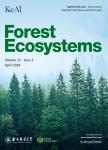Allometry-based estimation of forest aboveground biomass combining LiDAR canopy height attributes and optical spectral indexes
Allometry-based estimation of forest aboveground biomass combining LiDAR canopy height attributes and optical spectral indexes作者机构:State Key Laboratory of Vegetation and Environmental ChangeInstitute of BotanyChinese Academy of SciencesBeijing100093China University of Chinese Academy of SciencesBeijing100049China Plant Phenomics Research CentreAcademy for Advanced Interdisciplinary StudiesCollaborative Innovation Centre for Modern Crop Production co-sponsored by Province and MinistryNanjing Agricultural UniversityNanjing210095China Department of Environmental SciencesPolicy and ManagementUniversity of CaliforniaBerkeleyCA94720-3114USA Division of Agriculture and Natural ResourcesUniversity of CaliforniaBerkeleyCA94720-3114USA College of Geography and Remote Sensing SciencesXinjiang UniversityUrumqiXinjiang830017China Xinjiang Lidar Applied Engineering Technology Research CenterUrumqiXinjiang830002China Xinjiang Land and Resources Information CenterUrumqiXinjiang830002China Institute of Remote Sensing and Geographic Information SystemSchool of Earth and Space SciencesPeking UniversityBeijing100871China
出 版 物:《Forest Ecosystems》 (森林生态系统(英文版))
年 卷 期:2022年第9卷第5期
页 面:617-629页
核心收录:
学科分类:0710[理学-生物学] 0830[工学-环境科学与工程(可授工学、理学、农学学位)] 0907[农学-林学] 0829[工学-林业工程] 09[农学] 0903[农学-农业资源与环境] 0901[农学-作物学] 0833[工学-城乡规划学] 0713[理学-生态学] 0834[工学-风景园林学(可授工学、农学学位)]
基 金:supported by the Strategic Priority Research Program of Chinese Academy of Sciences(Grant No.XDA19050401) the National Natural Science Foundation of China(41871332,31971575,41901358)
主 题:Forest aboveground biomass Drone LiDAR Allometric relationship Power law Tree height Vegetation index
摘 要:Accurate estimates of forest aboveground biomass(AGB)are essential for global carbon cycle studies and have widely relied on approaches using spectral and structural information of forest canopies extracted from various remote sensing ***,combining the advantages of active and passive data sources to improve estimation accuracy remains ***,we proposed a new approach for forest AGB modeling based on allometric relationships and using the form of power-law to integrate structural and spectral *** 60 km^(2) of drone light detection and ranging(LiDAR)data and 1,370 field plot measurements,covering the four major forest types of China(coniferous forest,sub-tropical broadleaf forest,coniferous and broadleaf-leaved mixed forest,and tropical broadleaf forest),were collected together with Sentinel-2 images to evaluate the proposed *** results show that the most universally useful structural and spectral metrics are the average values of canopy height and spectral index rather than their maximum *** with structural attributes used alone,combining structural and spectral information can improve the estimation accuracy of AGB,increasing R^(2) by about 10%and reducing the root mean square error by about 22%;the accuracy of the proposed approach can yield a R^(2) of 0.7 in different forests *** proposed approach performs the best in coniferous forest,followed by sub-tropical broadleaf forest,coniferous and broadleaf-leaved mixed forest,and then tropical broadleaf ***,the simple linear regression used in the proposed method is less sensitive to sample size and outperforms statistically multivariate machine learning-based regression models such as stepwise multiple regression,artificial neural networks,and Random *** proposed approach may provide an alternative solution to map large-scale forest biomass using space-borne LiDAR and optical images with high accuracy.



